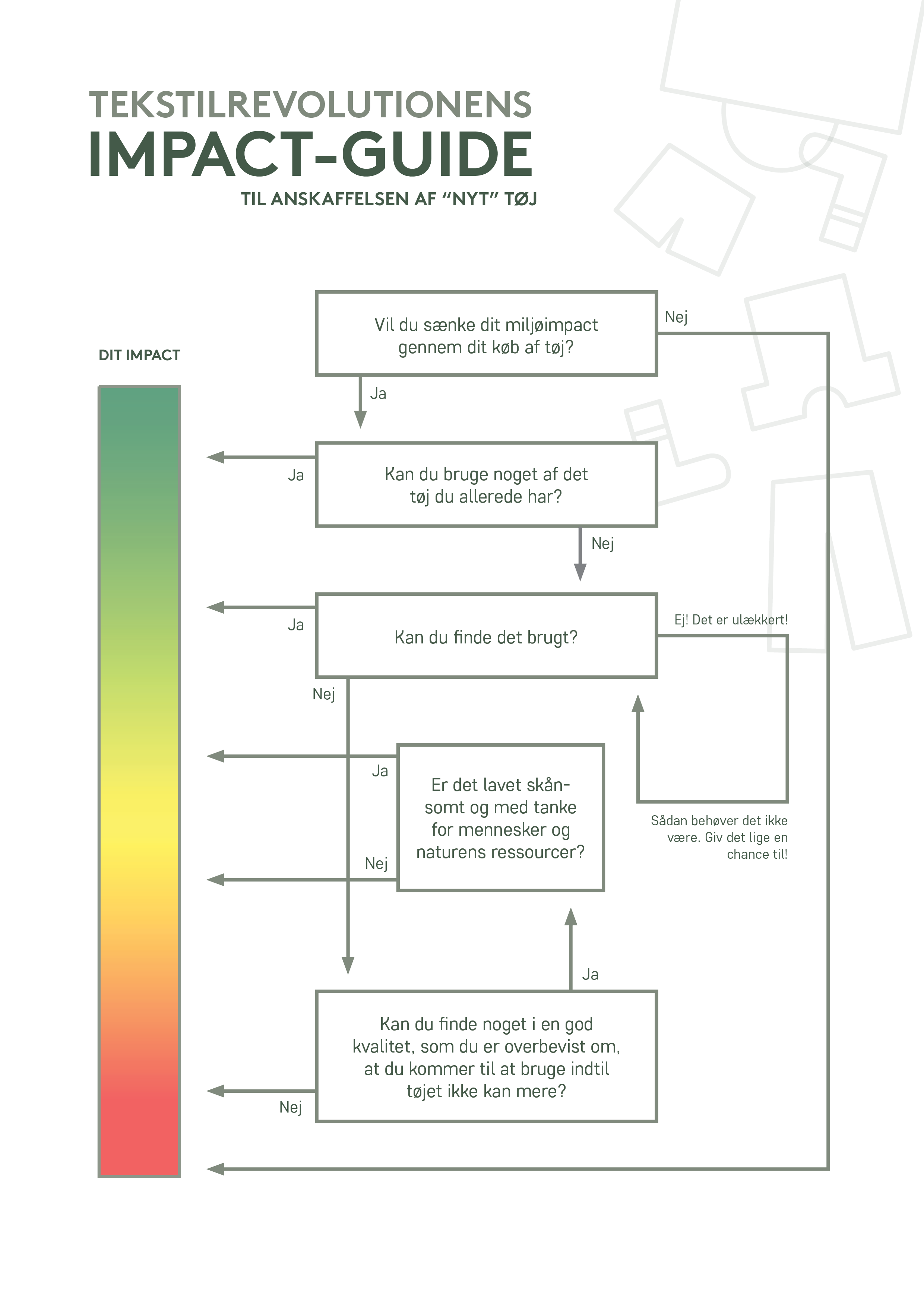Impact Guide
En guide, der hjælper dig at træffe bedre valg når du overvejer om du skal købe noget nyt.
A guide that helps you make better choices when considering whether to purchase new clothes.
Are you considering a ‘new’ purchase for your wardrobe?
If so, you should make sure that your impact on the world is as small as possible. But it can be difficult to know what to opt for. This is why we have made a guide to help you understand how low or high your current impact is, depending on your purchasing habits – and which factors to bear in mind when acquiring ‘new’ clothes in the future.
Follow the arrows to see your impact on the spectrum of green (lower) and red (higher).

Have a look in your wardrobe: can you use or repair what you already have?
As a consumer, you can significantly reduce your environmental impact by using the clothes you already own. Go through your wardrobe – are there clothes you perhaps haven’t used because they were hidden at the back, which you can use now? If you have clothes that, for instance, have a button missing, or a tear, you can either try your hand at repairing them yourself, or ask a friend or relative to help you with it.
Visit a flea market or download secondhand apps: can you find something used?
If you don’t believe you cannot use or repair your existing garments, try finding something second hand. You might find what you are looking for on Trendsales or Tise – these are apps that function as second-hand clothing stores. You can also arrange a clothing swap with your friends – perhaps they have exactly what you are looking for. Do you find used clothes unappealing? If so, we recommend that you take a look at the next flea market or download the above-mentioned apps; you will see that lots of clothes are sold as second hand which have actually never been worn.
The reason you find yourself in the green end of the spectrum by buying secondhand, is that these clothes have already been produced, and the proceeds of their resale does not directly support the use of new resources. By using second-hand to meet your garments needs, you also postpone or erase your own need to make use of new resources. This is a key part of reducing our impact on the world; we have to show the market that it mustn’t overproduce.
Examine the quality, consider whether you will use it for a long time, and how it was produced.
If you have considered the first two steps, but still want something new, you should go for clothes of good quality, and consider whether you will use it until it is worn out. If you are certain that you will use the garment for a long time, try to find something that is produced with care and in consideration with people and nature’s resources.
Overvejer du at købe noget “nyt” til din garderobe?
I så fald skal du sørge for at dit aftryk på verden er så lille som muligt. Men det kan være svært at vide hvad præcis hvad man skal gå efter.
Tekstilrevolutionen har derfor udviklet en guide, der skal hjælpe dig at forstå hvor lavt eller højt dit nuværende aftryk er, og hvilke faktorer du skal gå efter når du vil købe “nyt” tøj i fremtiden.
Følg pilene, så lander du, afhængigt af dine købvaner i den grønnere eller rødere enden af spektret. Det viser hvor højt eller lavt dit aftryk er.

Kig i din garderobe: kan du bruge eller reparere noget du allerede har?
Som forbruger kan du reducere dit miljøimpact væsentligt ved at bruge noget af det tøj du allerede har i dit skab. Gå igennem tøjet i din garderobe og overveje om du ikke kan finde noget, du f.eks. ikke har brugt fordi at det ligger bagerst. Hvis du har tøj, der f.eks. mangler en knap eller har et hul og skal repareres eller modificeres, kan du enten prøve at gøre det selv eller få en veninde/ven eller nogen i familien til at gøre det.
Gå på loppemarked eller downloade secondhand-apps: kan du finde noget brugt?
Hvis du mener at du hverken kan bruge eller reparere noget af det du allerede har, se hvis du kan finde det brugt. Det kan være at du finder det på Trendsales eller Tise – apps, der fungerer som secondhand-tøj platformer – eller på loppemarked, i en vintage butik eller second hand butik. Du kan også arrangere et tøjbytte med dine venner – måske har de noget liggende, som er lige præcis det du havde søgt.
Synes du at brugt tøj er ulækkert? Så ville vi anbefale at du tager en kig på næste loppemarked eller downloader en af de ovennævnte apps. Der findes faktisk en masse nyt tøj, der var et fejlkøb og ikke er blevet brugt af køberen.
Grunden til at du befinder dig i den grønne ende af spektret, er at brugt tøj allerede er blevet produceret. Du undgår eller udskyder dermed at støtte op om noget, der bruger nye ressourcer. For at mindske dit aftryk på verden, er det det handler om: at signalere til market, at der ikke skal overproduceres.
Kigge på kvaliteten, vurdere hvis du vil bruge det i lang tid og hvordan det er produceret.
Hvis du har overvejet de første to trin, men stadig vil have noget nyt, skal du gå efter tøj af god kvalitet og vurdere, hvis du kommer til at bruge det indtil tøjet ikke kan mere. Hvis du er overbevist om at du kommer til at gå i tøjet i lang tid, skal du finde noget, der er produceret på en skånsom måde og med tanke på mennesker og naturens ressourcer.

Tekstilrevolutionen
Esromgade 15, 1001 stuen,
2200 København N
